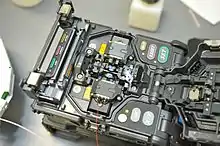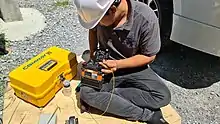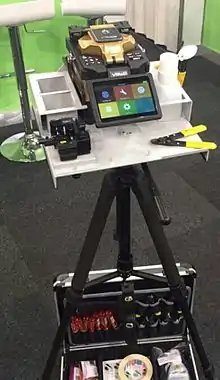
Fiber spliced, still unprotected

COMWAY fusion splicing

INNO View 7 splicer on a tripod and work table
Fusion splicing is the act of joining two optical fibers end-to-end. The goal is to fuse the two fibers together in such a way that light passing through the fibers is not scattered or reflected back by the splice, and so that the splice and the region surrounding it are almost as strong as the intact fiber. The source of heat used to melt and fuse the two glass fibers being spliced is usually an electric arc,[1] but can also be a laser, a gas flame, or a tungsten filament through which current is passed.
Governing standards
ANSI/EIA/TIA-455
See also
References
- ↑ Alwayn, Vivek (2004). Optical Network Design and Implementation. Cisco Press. ISBN 9781587051050.
Methods of Removing Matrix from Fiber Optic Cable" Patent 7,125,494
Further reading
- "How to Precision Clean All Fiber Optic Connections": Edward J. Forrest, Jr. ISBN 1505549728, 9781505549720
- Fiber Optic Association
This article is issued from Wikipedia. The text is licensed under Creative Commons - Attribution - Sharealike. Additional terms may apply for the media files.